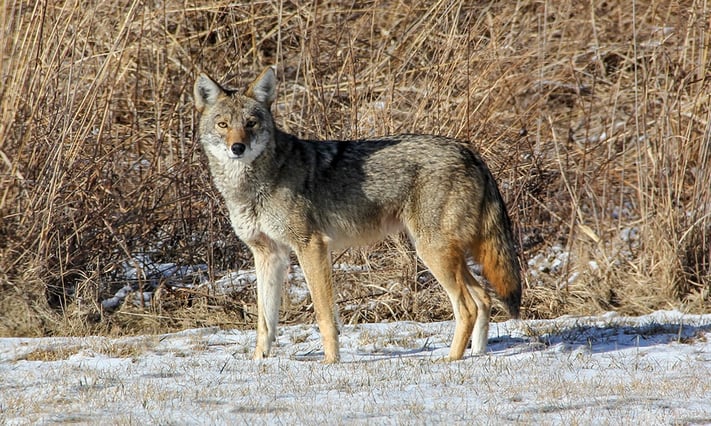News Release
Coyotes Out Looking for Love as Mating Season Peaks
Late winter is mating season for coyotes, and the Forest Preserve District of DuPage County reminds residents it’s not unusual to see these animals as they search for mates and monitor their territories.
“Just because you see a coyote isn’t a cause for alarm. Consider yourself lucky, and enjoy the rare opportunity to observe it from a safe distance,” says Forest Preserve District ecologist Dan Thompson. “Whether you see them or not, coyotes are all around, and the more we can understand they’re just trying to live their lives, the more we can safely share our neighborhoods.”
Coyotes, after all, play a vital role in the ecological community by keeping populations of rodents and other small animals in check.
In winter, when coyotes may spend more time foraging for food, they can also be easier to spot on the snowy landscape or in areas with limited vegetation and places to hide.
Thompson acknowledges coyotes can be intimidating due to their apparent large stature and may be more bold this time of year.
“They may view other canines, including dogs, as competition. Likewise, they might approach a female dog in heat as a potential mate,” he said.
Still, he suggests that a few simple practices can keep most coyote encounters at bay.
- Keep your dog on a leash — even in a fenced backyard — and stay close, never leaving your pet unattended.
- Keep cats indoors.
- If you see a coyote at the same time and place more than once, change your routine as coyotes are generally creatures of habit.
- If you have a small dog and encounter a coyote, pick up your pet.
- If a coyote gets uncomfortably close, don’t turn and run. Instead, appear large, maintain good eye contact, and make loud noise.
- Visit dupageforest.org for more information on living with coyotes and ways to keep pets safe.
In DuPage, coyote breeding season peaks in late February or early March. Litters are born in April, and coyotes raise their young in dens until late June. This is the only time of year coyotes typically use dens, which are often vacant fox or woodchuck burrows but can also be under log or brush piles or in hollow trees or abandoned buildings.
Thompson explains that female coyotes typically start mating in their second year and are only receptive to a male’s advances for around a week during this period. He further states that coyotes are generally monogamous and only seek a new partner when their previous one dies. He pointed to a multiyear study of urban coyotes in Chicago that showed no genetic evidence of polygamy or even of one of the pair leaving its mate while the other was still alive.
“Coyote encounters can happen any time of year, but we tend to see an increase during the fall dispersal and now as we move into breeding and pup rearing, or denning, seasons. We can’t reiterate it enough that more often than not these encounters occur without incident, but that doesn’t mean pet owners should leave their dogs unleashed or unattended.”
The Forest Preserve District of DuPage County has been connecting people to nature for more than 100 years. More than 6.2 million people visit its 60 forest preserves, 166 miles of trails, seven education centers, and scores of programs each year. For information, call 630-933-7200 or visit dupageforest.org, where you can also link to the District’s e-newsletter, Facebook, Twitter, Instagram and TikTok pages.

###